1 • It should be considered that the cognitive aspects of an environment’s legibility will be reflected in the design of any support information and graphics. A true wayfinding analysis might involve all aspects of a given environment from the standpoint of user interaction and experience. The overall design of the given area, the location and orientation of an information desk, the location of elevators and the distinction of pathways are all considerations that affect how users interact with, and within, an environment.
(Example: An expansive donor program at a children’s hospital is realized in the form of a moving butterfly garden—becoming the most significant landmark throughout an entire medical facility)






